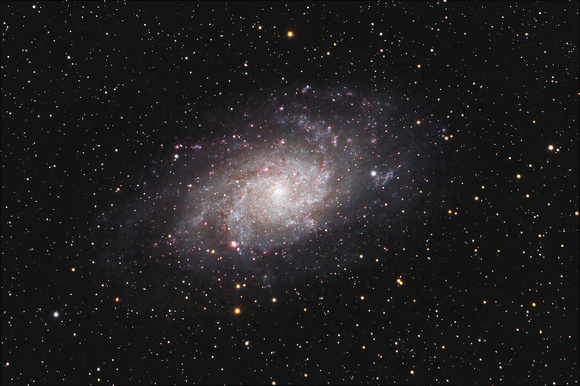Canon 350D Hap Griffin Baader Mod32x180sec at iso 160013x600sec Ha with Baader 7nm Ha filter at iso 1600
30 Darks/Flats/Bias
APM/TMB 130/780 with APM Field FlattenerWikipedia Astronomy Picture of the Week - Week 16, 2010Sky and Telescope Editor's Choice September 22, 2008Astronomy Magazine Picture of the Day September 8, 2008Taken almost one year to the day, this image of M33 replaces last year's effort.Hydrogen Alpha Dataused in this image. RGB versionof this image.Hydrogen enhancement using Chris Schur's method for Hydrogen Enhanced Galaxies.The RGB image is split into it's components and the data from the Ha exposureis projected onto the R channel at 100% opacity with the layer set to "screen". The Ha data is also projected onto the B layer in the same manner, but at 15% opacity, which provides color for the H beta line. The RGB channels are then recombined into an image by starting with the G data as the background layer and then projecting the HaR and HaB layers on top of it as "lighten" layers.The Triangulum Galaxy Messier 33 (M33, NGC 598) is another prominent member of the
Local Group of galaxies. This galaxy is small compared to its big apparent neighbor, the
Andromeda galaxy M31, and to our
Milky Way galaxy, but by this more of average size for spiral galaxies in the universe. M33 may be a remote but gravitationally bound companion of the
Andromeda galaxy M31.
Several knots in the spiral arms of M33 have been assigned their own NGC catalog numbers - the largest of which in this image is in the upper mid-right and is
NGC 604. This is
one of the largest H II regions known at all: it has a diameter of nearly 1500 light-years, and a spectrum similar to the Orion nebula
M42. Over 200 young hot massive stars (of 15 to 60 solar masses) have recently formed here.
Some other catalogued objects are identified in this
map.
September 6 and 9, 2008


